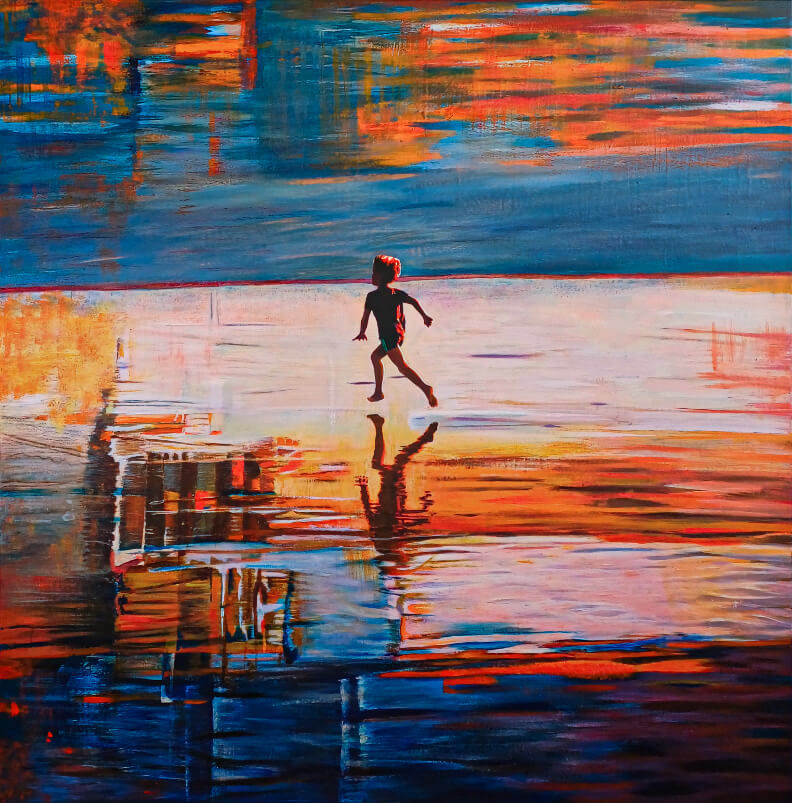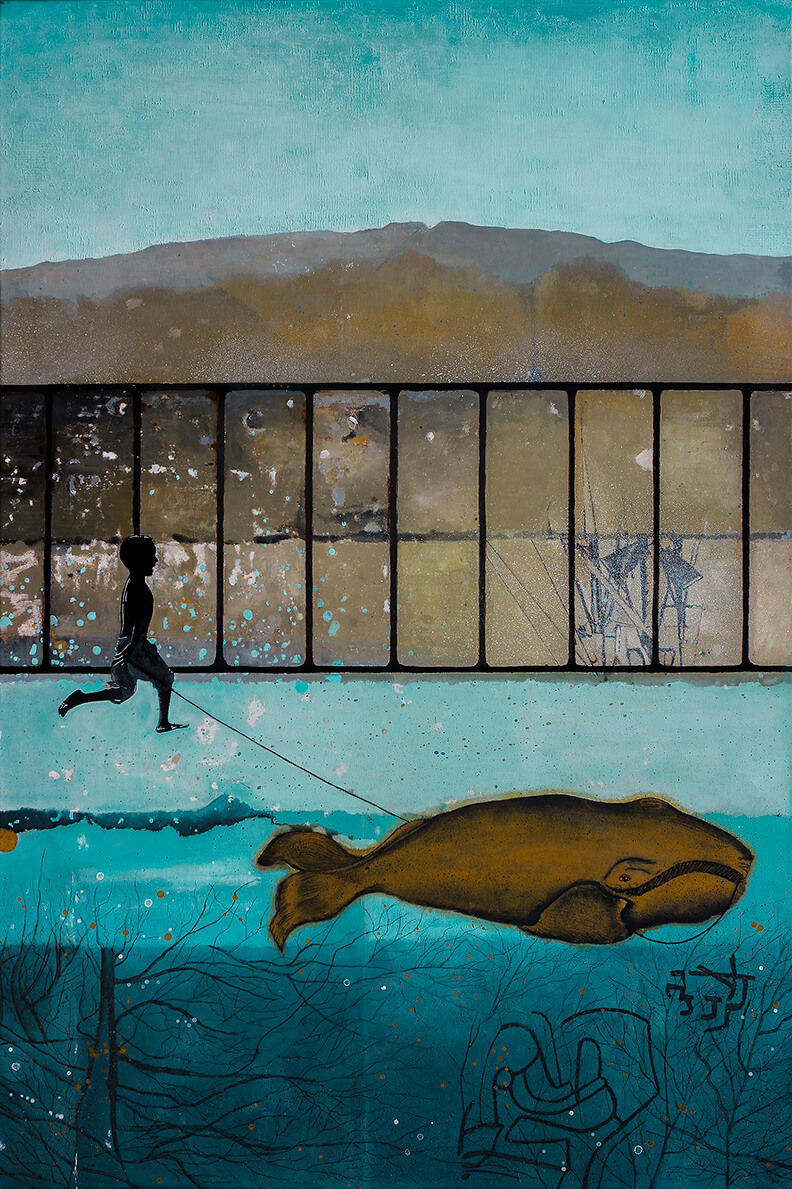Alone but not lost – The power of lonely figures in silent landscapes
- dbwaterman
- Jul 6
- 5 min read
Updated: Sep 15
A single small figure in a painting usually affects us more than a busy image full of people. Why is that?
One person in a landscape or urban landscape creates the story and immediately draws all the attention to themselves.
As a viewer, you immediately start asking questions about the reason for that figure's presence in that place. And why alone?
Many people immediately feel connected to that person. In my work, I keep coming back to that one moment: a child or a person, almost monochrome, lost in space – but never really alone.
The people in my artworks do not exist separately from their surroundings. They are part of it, interwoven with the weathered walls, rough concrete surfaces, and old layers of paper on which they appear. They are traces, symbols, shadows.
In this blog, I try to explain why we identify so strongly with these figures and how I integrate them into my art as silent carriers of stories, emotions, and memories.
Recognition in lonely figures
The lonely figures in my paintings evoke questions and a strong emotional response. This does not necessarily have to be sadness, but rather a feeling of reflection, connection, or recognition.
For example, in the image of a person, silent and small, placed in a large, empty landscape, we see something of ourselves. We feel what that person must feel. Unconsciously, we recognize images of doubt, longing, loss, or, conversely, freedom.
I paint children, adults, silhouettes, and sometimes more detailed faces. Almost always in black and white to emphasize the contrast. They are present in the paintings in a tranquil way. The children are active, the adults inactive.
They usually do not look at the viewer, but inward. The figures have no fixed identity. They are universal, abstract in their presence. This allows the viewer to project themselves into them and also look inward.
How I place figures in my landscapes
I never place my people in traditional landscapes. It is always a special landscape with a message; a desert, a marshland, or a dark forest. An urban landscape where industry is advancing or where there are traces of decay.
My landscapes are always constructed from different layers – literally and figuratively. Layer upon layer, I add mixed media: collage fragments, image transfers, acrylic paint, texture paste, sometimes sand or pigment.
For my landscapes, these are usually tranquil natural images. Sometimes with flowers, grasses, and beaches... But often also combined with weathered concrete-look surfaces.
For my urban landscapes, the background looks rough: rough concrete walls, rusted surfaces, weathered walls full of cracks, stains, and peeling paint.
I then place the figure in that layered landscape. Often alone, occasionally together. I want them to blend into the background; they are connected to it. It should appear as if they are made of the same materials: textured backgrounds, yellowed paper, torn posters, old texts.
I work with natural tones, black and white, muted colors. This makes the image feel calm, quiet, sometimes melancholic. The silent space around a figure is often just as important as the figure itself. Emptiness is part of the story. (See also blog 4: The power of silence and space, coming soon)
Story and emotion without explanation
By the way I place my figures in the landscape, I deliberately leave open what exactly they are feeling or thinking. There is never a concrete story, but rather an image that offers room for meaning. I want people who view my work to be able to fill in for themselves who the figures are.
Some see a child that reminds them of their childhood. Others recognize their own sense of loneliness, which everyone experiences at times, a sense of loss, or, conversely, a sense of peace and acceptance.
That is what makes my art personal. The lonely figure becomes a mirror. Art does not have to explain what you should feel. My paintings are made to let you feel what is already inside you. The empty landscapes, dark forests, weathered art, damaged surfaces, and use of rough textures reinforce that effect: they bring the subconscious closer.
Sometimes I literally use old texts in one of the layers, so that words appear behind a figure. Not always legible, but palpable. It is clear to the viewer that they mean something. A sentence that lingers. That too is part of the story: art that does not tell a linear story, but is layered. Like memories.
Imperfections as strength: Wabi-Sabi in figure and environment
Some of my works tie in very well with the Japanese principle of Wabi-Sabi (see blog 3): the beauty of the imperfect, the transient, the incomplete. A lonely figure, placed in a weathered landscape, illustrates this very well.
The weathered surfaces of a concrete wall, the yellowed and dried-up grasslands, and peeling paint on wooden planks show that everything changes, wears out, and passes away. My figures—perhaps a child, perhaps an adult lost in thought—live with that transience. Not against it, but within it. They feel at home there.
For me and for the Wabi-Sabi principle, imperfection is not a flaw, but a quality. It is precisely because the environment is not smooth that the image feels authentic. It feels like a gift. I am given beautiful images to use in my artworks for free. Images with a past, a story, a life that has been lived. Art does not have to be polished to be moving. On the contrary.
Loneliness in art
A theme such as loneliness in art is often initially seen as negative or too gloomy. But my artworks show that this does not have to be the case at all. In my paintings, the lonely figure is not a lost soul, but a conscious presence. Alone, yes. But not without meaning. My figures tell a story and want to make something clear with their presence.
The combination of rough, weathered textures, mixed media, collage, and silent figures offers space for comfort. Comfort in recognition. In tranquility. In the realization that silence, emptiness, and imperfection can also be valuable. (See also blog 5: Comfort in roughness, coming soon)
In a world full of noise and hustle and bustle, a quiet, still image can say a lot. That is what I hope to achieve: images that linger because of the story they tell. Because of the recognizability they offer. Not through harshness, but through softness. Not through complexity, but through depth.
Are you curious to see how these themes come to life in my work?
You are always welcome to visit my studio gallery at Strijp-S in Eindhoven, or take a look at my online portfolio.




















